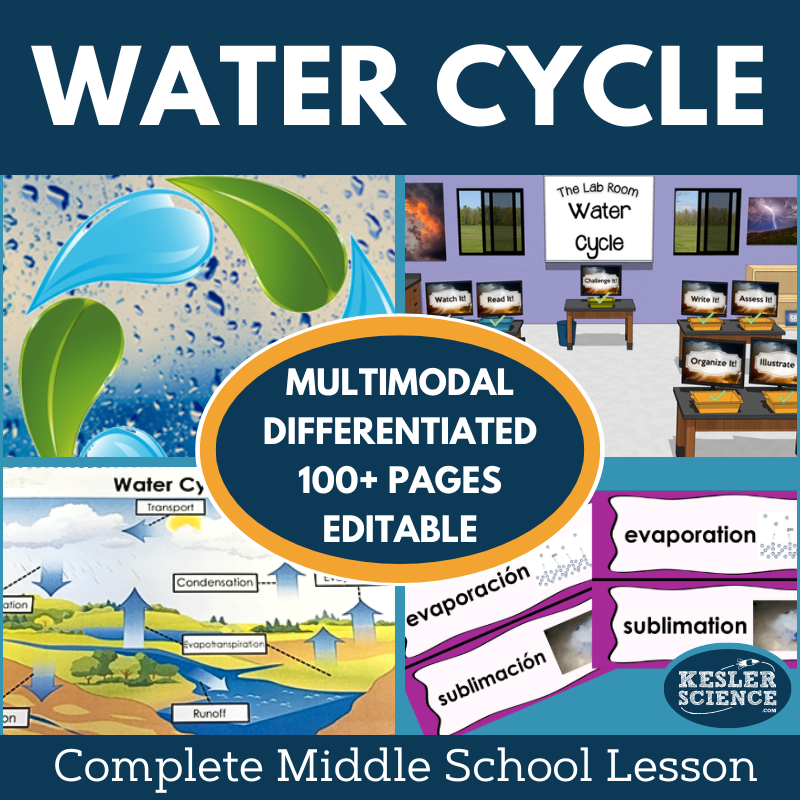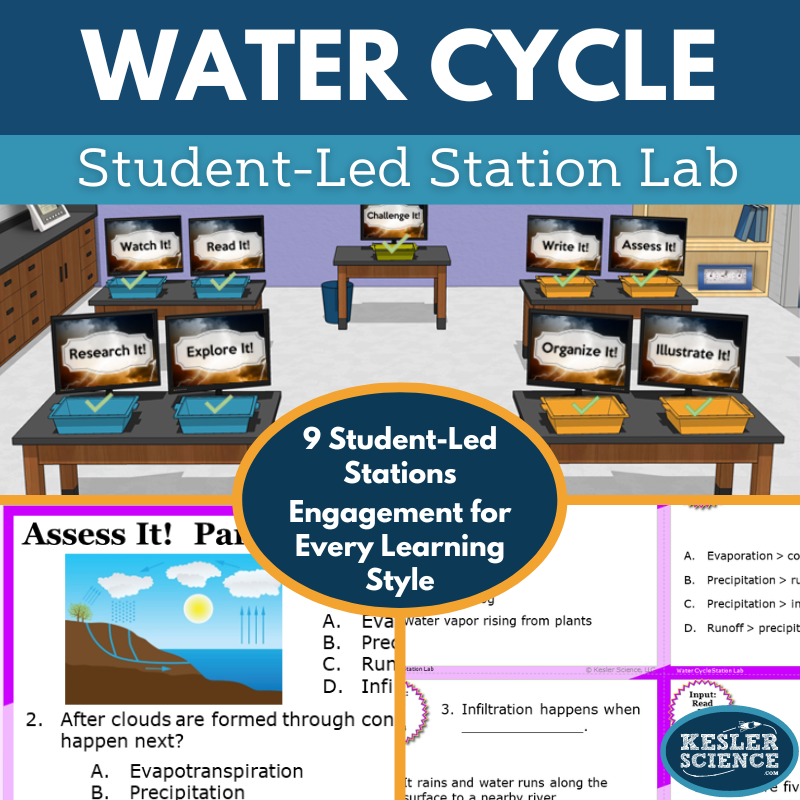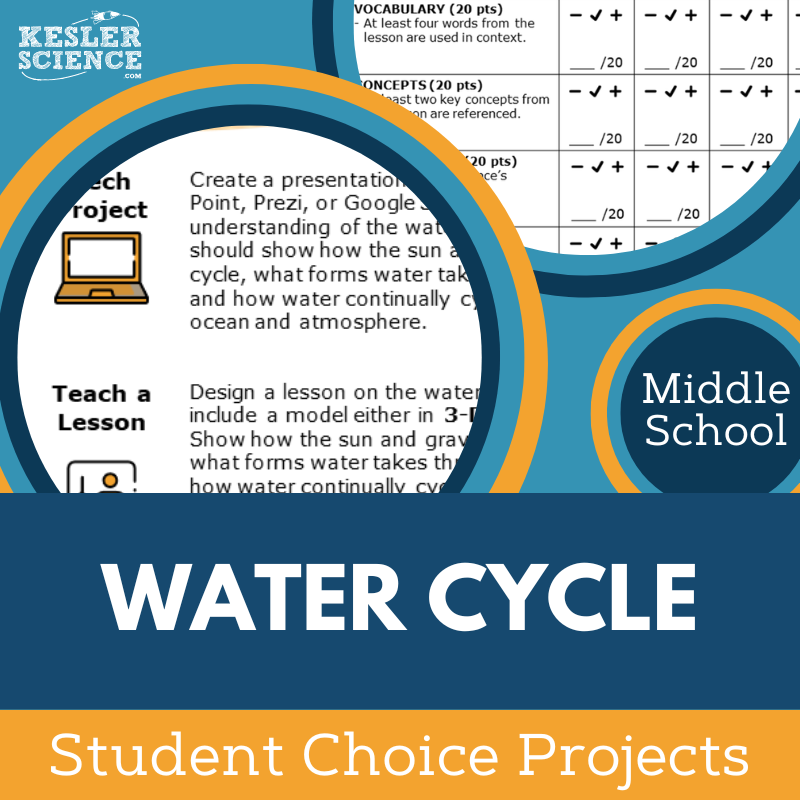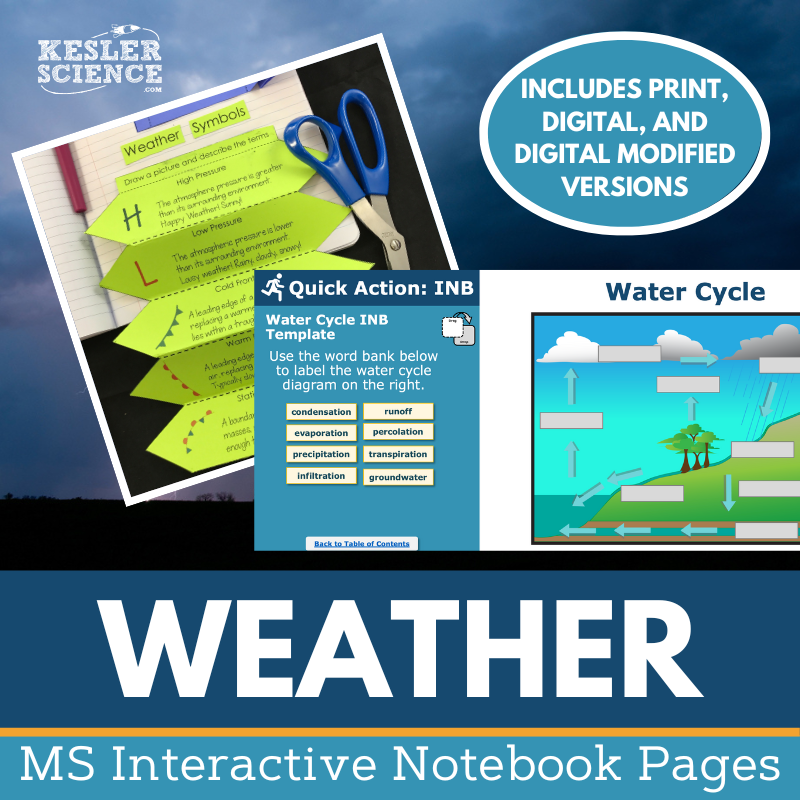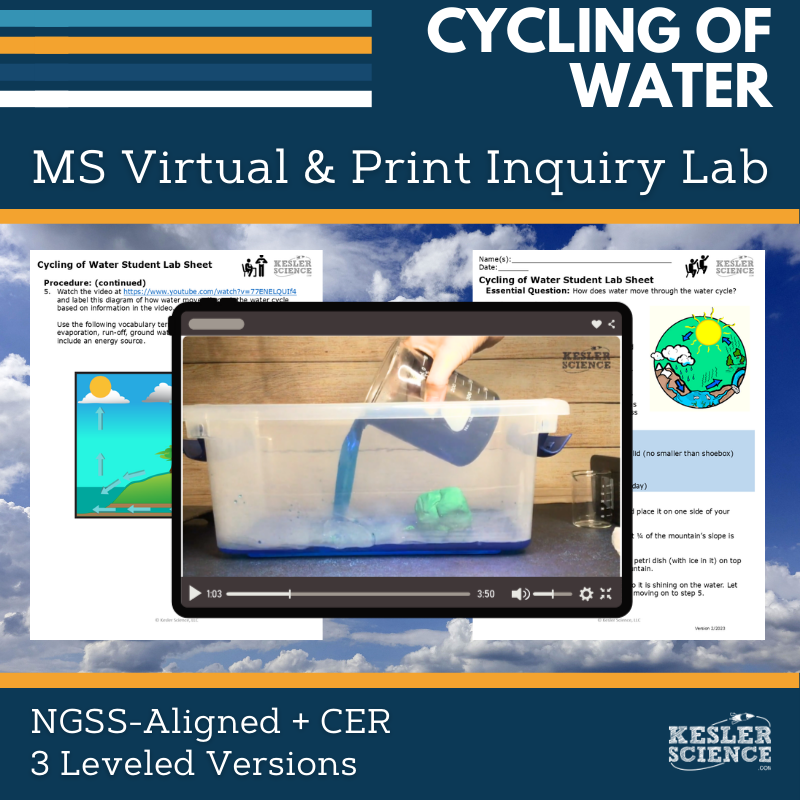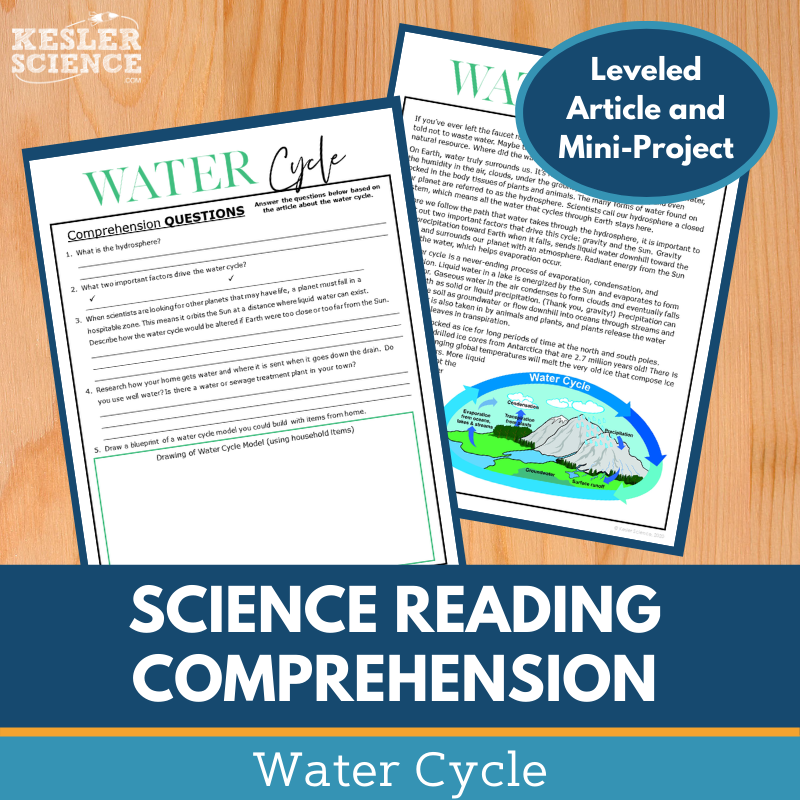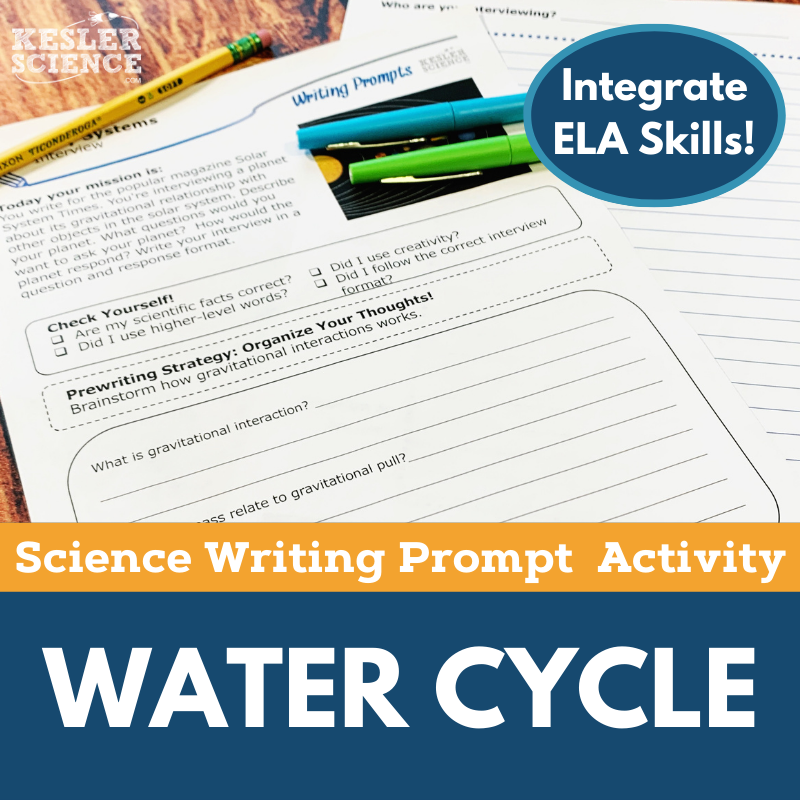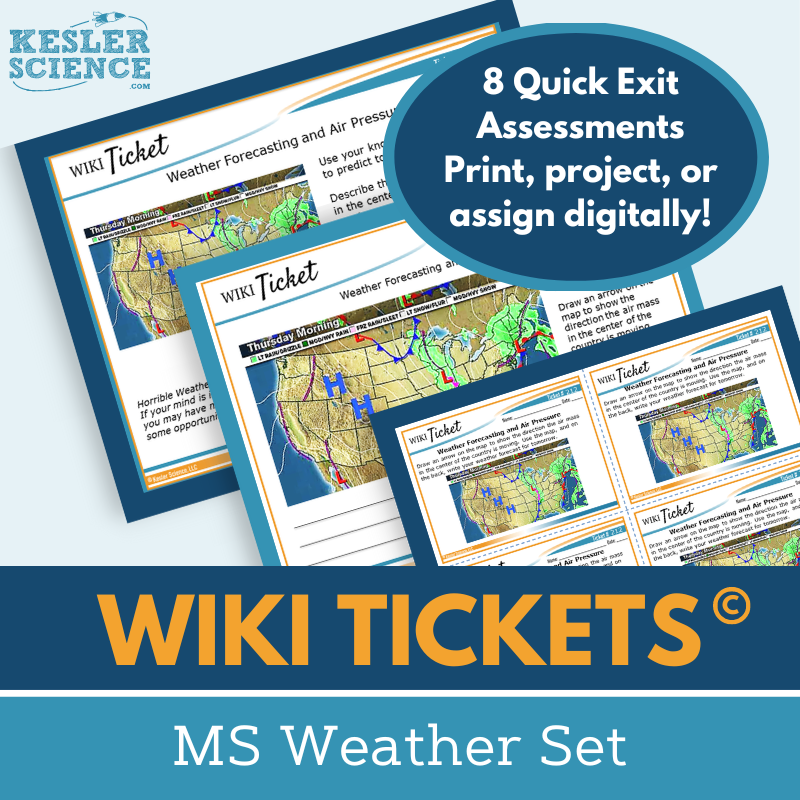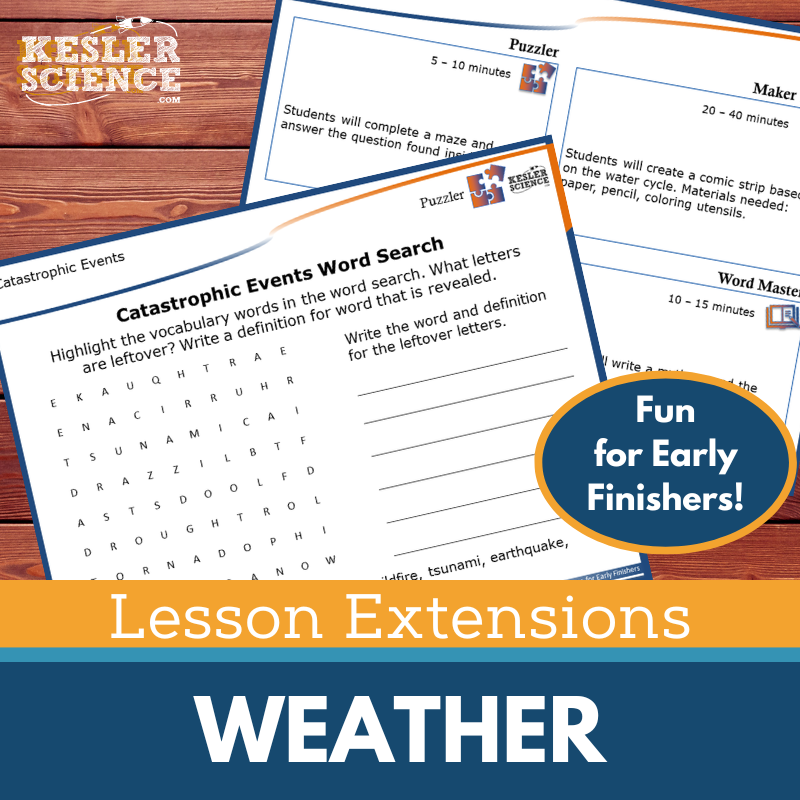Water Cycle Activities for Middle School Science
The Kesler Science Water Cycle resources provide a comprehensive, engaging, and differentiated unit for middle school students to explore the water cycle. With flexible assessments, projects, and differentiated activities, teachers can easily support diverse learners while fostering in-depth understanding of the water cycle. All of the following materials are also included in the Kesler Science Membership.
The Kesler Science Complete 5E Water Cycle Lesson offers everything needed for a multi-day, engaging water cycle unit for 6th to 8th grade students. This lesson uses the 5E model—Engagement, Exploration, Explanation, Elaboration, and Evaluation—to guide students through understanding how water cycles through land, oceans, and the atmosphere, and how it is influenced by the Sun and gravity. With minimal prep time, teachers can focus on facilitating student success, with differentiated and multimodal materials to cater to all learners.
The lesson includes a student-led station lab with nine stations covering various input and output activities. Stations like “Explore It!” provide hands-on experiments, while “Read It!” and “Watch It!” use reading and videos to reinforce concepts. Output stations such as “Illustrate It!” and “Write It!” encourage students to demonstrate their knowledge creatively. An additional challenge station provides early finishers with extension activities to deepen their learning.
With flexibility for both in-person and virtual learning, this resource includes editable PowerPoints, interactive notebooks, and Spanish translations of vocabulary and materials. The lesson also features formative assessments, review questions, and customizable project options to extend learning both in-class and at home, ensuring all students have the opportunity to succeed.
The Kesler Science Complete 5E Water Cycle Lesson offers everything needed for a multi-day, engaging water cycle unit for 6th to 8th grade students. This lesson uses the 5E model—Engagement, Exploration, Explanation, Elaboration, and Evaluation—to guide students through understanding how water cycles through land, oceans, and the atmosphere, and how it is influenced by the Sun and gravity. With minimal prep time, teachers can focus on facilitating student success, with differentiated and multimodal materials to cater to all learners.
The lesson includes a student-led station lab with nine stations covering various input and output activities. Stations like “Explore It!” provide hands-on experiments, while “Read It!” and “Watch It!” use reading and videos to reinforce concepts. Output stations such as “Illustrate It!” and “Write It!” encourage students to demonstrate their knowledge creatively. An additional challenge station provides early finishers with extension activities to deepen their learning.
With flexibility for both in-person and virtual learning, this resource includes editable PowerPoints, interactive notebooks, and Spanish translations of vocabulary and materials. The lesson also features formative assessments, review questions, and customizable project options to extend learning both in-class and at home, ensuring all students have the opportunity to succeed.
The Kesler Science Water Cycle Station Lab is a modular, student-led activity designed to engage middle school students in learning about the water cycle. Through nine differentiated stations, students explore how water moves among land, ocean, and atmosphere, and how the sun and gravity affect the cycle. This student-centered approach allows students to take charge of their learning while teachers facilitate the process, making this a highly effective lesson for diverse learning styles.
Each station features a variety of input and output activities, including hands-on demonstrations, research tasks, readings, and videos. Stations like “Explore It!” and “Research It!” help students apply and investigate new concepts, while “Read It!” and “Watch It!” provide additional ways to engage with the material. Output stations, such as “Organize It!” and “Illustrate It!”, encourage students to demonstrate their understanding through drawings and organization of ideas.
The lab also includes a bonus “Challenge It!” station for early finishers and advanced learners. These stations are designed to work both in-person and virtually, with digital options for many of the tasks. The modular design, with resources like task cards and manipulatives, ensures a personalized, engaging experience for every student, whether in the classroom or remote learning.
The Kesler Science Water Cycle Station Lab is a modular, student-led activity designed to engage middle school students in learning about the water cycle. Through nine differentiated stations, students explore how water moves among land, ocean, and atmosphere, and how the sun and gravity affect the cycle. This student-centered approach allows students to take charge of their learning while teachers facilitate the process, making this a highly effective lesson for diverse learning styles.
Each station features a variety of input and output activities, including hands-on demonstrations, research tasks, readings, and videos. Stations like “Explore It!” and “Research It!” help students apply and investigate new concepts, while “Read It!” and “Watch It!” provide additional ways to engage with the material. Output stations, such as “Organize It!” and “Illustrate It!”, encourage students to demonstrate their understanding through drawings and organization of ideas.
The lab also includes a bonus “Challenge It!” station for early finishers and advanced learners. These stations are designed to work both in-person and virtually, with digital options for many of the tasks. The modular design, with resources like task cards and manipulatives, ensures a personalized, engaging experience for every student, whether in the classroom or remote learning.
The Kesler Science Water Cycle Student Choice Projects delegate middle school students to choose from multiple project options that suit their individual learning and output styles. With nine project choices and the flexibility to "design your own," students can showcase their understanding of the water cycle in creative ways. The grading rubric is adaptable, allowing for assessments by teachers, peers, or the students themselves.
These dynamic projects offer multimodal options, encouraging personalized learning and allowing students to express their knowledge through various formats. The lesson includes a Teacher Directions page for support and suggestions, along with editable rubrics that assess vocabulary, concepts, and clarity.
Differentiation is built in with two versions of the project page, including modified options for students needing additional support. Teachers can also challenge advanced learners by assigning a combination of projects while using the same rubric. Supplies are minimal, using common classroom materials like paper, markers, and scissors, with many projects also offering digital alternatives.
The Kesler Science Water Cycle Student Choice Projects delegate middle school students to choose from multiple project options that suit their individual learning and output styles. With nine project choices and the flexibility to "design your own," students can showcase their understanding of the water cycle in creative ways. The grading rubric is adaptable, allowing for assessments by teachers, peers, or the students themselves.
These dynamic projects offer multimodal options, encouraging personalized learning and allowing students to express their knowledge through various formats. The lesson includes a Teacher Directions page for support and suggestions, along with editable rubrics that assess vocabulary, concepts, and clarity.
Differentiation is built in with two versions of the project page, including modified options for students needing additional support. Teachers can also challenge advanced learners by assigning a combination of projects while using the same rubric. Supplies are minimal, using common classroom materials like paper, markers, and scissors, with many projects also offering digital alternatives.
The Kesler Science Weather Interactive Notebook Bundle offers both print and digital versions to enhance student engagement while teaching key weather concepts. Perfect for traditional classrooms, 1:1 settings, or distance learning, this bundle covers important topics such as the atmosphere, catastrophic events, convection currents, hurricane formation, the water cycle, and weather maps.
Digital versions include a customizable PowerPoint file that can be uploaded to Google Slides or integrated into platforms like MS Teams, Schoology, and Canvas. It also features reflection pages, spaces for student notes, and a modified version for students with accommodations, all supported by a teacher answer key.
The paper version includes complete blank templates for the interactive notebook, pre-filled versions for students needing modifications or those who missed class, and color photos that demonstrate how each template is used, making it a versatile tool for teachers and students alike.
The Kesler Science Weather Interactive Notebook Bundle offers both print and digital versions to enhance student engagement while teaching key weather concepts. Perfect for traditional classrooms, 1:1 settings, or distance learning, this bundle covers important topics such as the atmosphere, catastrophic events, convection currents, hurricane formation, the water cycle, and weather maps.
Digital versions include a customizable PowerPoint file that can be uploaded to Google Slides or integrated into platforms like MS Teams, Schoology, and Canvas. It also features reflection pages, spaces for student notes, and a modified version for students with accommodations, all supported by a teacher answer key.
The paper version includes complete blank templates for the interactive notebook, pre-filled versions for students needing modifications or those who missed class, and color photos that demonstrate how each template is used, making it a versatile tool for teachers and students alike.
The Cycling of Water Inquiry Lab aligns with NGSS MS-ESS2-4 and guides students in creating a model to demonstrate how water moves through Earth’s systems, driven by solar energy and gravity. The lab is offered in both a hands-on printed version and a fully interactive digital format that includes a video demonstration. Each version incorporates comprehension questions, Claim-Evidence-Reasoning (C.E.R.) prompts, and reflection opportunities to deepen understanding.
This resource is designed with three levels of differentiation—Modified, Dependent, and Independent—to support all types of learners. The Modified version offers the most structure with guided supports, the Dependent version provides a mix of direction and inquiry, and the Independent version allows advanced students to take the lead. These differentiated pathways ensure that students are appropriately challenged while building scientific modeling skills.
In the print version, students will use materials like clay, clear containers, ice, and a heat lamp to simulate the water cycle. The digital version requires no materials and is ideal for absent students or classrooms without supplies. Teachers are supported with editable files, answer keys, video links, and built-in flexibility to adapt for classroom needs.
The Cycling of Water Inquiry Lab aligns with NGSS MS-ESS2-4 and guides students in creating a model to demonstrate how water moves through Earth’s systems, driven by solar energy and gravity. The lab is offered in both a hands-on printed version and a fully interactive digital format that includes a video demonstration. Each version incorporates comprehension questions, Claim-Evidence-Reasoning (C.E.R.) prompts, and reflection opportunities to deepen understanding.
This resource is designed with three levels of differentiation—Modified, Dependent, and Independent—to support all types of learners. The Modified version offers the most structure with guided supports, the Dependent version provides a mix of direction and inquiry, and the Independent version allows advanced students to take the lead. These differentiated pathways ensure that students are appropriately challenged while building scientific modeling skills.
In the print version, students will use materials like clay, clear containers, ice, and a heat lamp to simulate the water cycle. The digital version requires no materials and is ideal for absent students or classrooms without supplies. Teachers are supported with editable files, answer keys, video links, and built-in flexibility to adapt for classroom needs.
The Kesler Science Water Cycle Reading Comprehension Activity engages middle school students in exploring Earth’s systems through a nonfiction article about the water cycle. Students answer comprehension questions and develop a model to describe how energy from the Sun and gravity drive the cycling of water. This activity enhances science literacy and critical thinking while providing an interactive learning experience.
Designed for grades 6–8 (and advanced 5th graders), the resource includes leveled articles with Lexile levels of 1100–1300, 5–7 corresponding questions, and a hands-on mini-project. Supporting materials such as Cornell notes templates, colorful graphics, and differentiated options ensure accessibility for all learners. The activity is suitable for print or digital formats, making it ideal for classroom or remote learning environments.
This versatile resource is perfect for cross-curricular lessons, sub plans, extra credit, or whole-class instruction. Teachers can integrate it throughout a unit to build reading comprehension and science literacy. With engaging content and flexible delivery options, the activity encourages meaningful discussions and deepens students’ understanding of the water cycle.
The Kesler Science Water Cycle Reading Comprehension Activity engages middle school students in exploring Earth’s systems through a nonfiction article about the water cycle. Students answer comprehension questions and develop a model to describe how energy from the sun and gravity drive the cycling of water. This activity enhances science literacy and critical thinking while providing an interactive learning experience.
Designed for grades 6–8 (and advanced 5th graders), the resource includes leveled articles with Lexile levels of 1100–1300, 5–7 corresponding questions, and a hands-on mini-project. Supporting materials such as Cornell notes templates, colorful graphics, and differentiated options ensure accessibility for all learners. The activity is suitable for print or digital formats, making it ideal for classroom or remote learning environments.
This versatile resource is perfect for cross-curricular lessons, sub plans, extra credit, or whole-class instruction. Teachers can integrate it throughout a unit to build reading comprehension and science literacy. With engaging content and flexible delivery options, the activity encourages meaningful discussions and deepens students’ understanding of the water cycle.
The Kesler Science Water Cycle Writing Prompt Activity allows middle school students to explore earth science concepts through creative narrative writing. This engaging, student-centered resource supports science reasoning and provides a fun way to assess and extend understanding of the water cycle. Designed for in-person or virtual learning, it keeps students connected and motivated both inside and outside the classroom.
The activity includes full-sized and half-sheet handouts, teacher directions with rubrics, and a digital interactive version for flexibility. Students can use pre-writing strategies and templates to craft their narratives, while teachers can project prompts or share screens to save paper. This low-prep resource works seamlessly with other Kesler products and supports differentiated learning needs.
Ideal for cross-curricular projects, formative assessments, early finisher activities, or extra credit, this writing prompt is a versatile tool for fostering creativity and science literacy. It’s perfect for interactive notebooks, TELPAS samples, or as a choice project that combines science exploration with imaginative storytelling.
The Kesler Science Water Cycle Writing Prompt Activity allows middle school students to explore earth science concepts through creative narrative writing. This engaging, student-centered resource supports science reasoning and provides a fun way to assess and extend understanding of the water cycle. Designed for in-person or virtual learning, it keeps students connected and motivated both inside and outside the classroom.
The activity includes full-sized and half-sheet handouts, teacher directions with rubrics, and a digital interactive version for flexibility. Students can use pre-writing strategies and templates to craft their narratives, while teachers can project prompts or share screens to save paper. This low-prep resource works seamlessly with other Kesler products and supports differentiated learning needs.
Ideal for cross-curricular projects, formative assessments, early finisher activities, or extra credit, this writing prompt is a versatile tool for fostering creativity and science literacy. It’s perfect for interactive notebooks, TELPAS samples, or as a choice project that combines science exploration with imaginative storytelling.
The Kesler Science Weather WIKI Tickets are engaging formative assessments designed for 6th-8th grade science topics, offering flexible options for checking student understanding. The Weather Set includes eight WIKI Tickets, each aligned to NGSS and TEKS standards, with five format choices: a projection version, three handout sizes (full, split, and quarter-page), and a digital version (editable PPT or Google Slides). These assessments provide a fun, interactive way to gauge student learning.
The WIKI Tickets can be used as exit tickets, bellringers, or during lessons to quickly assess students' grasp of concepts such as the water cycle, weather maps, and ocean currents. Each ticket helps reinforce key topics, ensuring that students are meeting learning goals in a creative, low-pressure way. A bonus table of contents file is included for easy reference to ensure standards alignment.
Perfect for both in-person and virtual learning, these assessments allow for seamless integration into various classroom settings. Whether projected in class or completed digitally, WIKI Tickets help educators gauge student progress and adapt instruction to meet their needs.
The Kesler Science Weather WIKI Tickets are engaging formative assessments designed for 6th-8th grade science topics, offering flexible options for checking student understanding. The Weather Set includes eight WIKI Tickets, each aligned to NGSS and TEKS standards, with five format choices: a projection version, three handout sizes (full, split, and quarter-page), and a digital version (editable PPT or Google Slides). These assessments provide a fun, interactive way to gauge student learning.
The WIKI Tickets can be used as exit tickets, bellringers, or during lessons to quickly assess students' grasp of concepts such as the water cycle, weather maps, and ocean currents. Each ticket helps reinforce key topics, ensuring that students are meeting learning goals in a creative, low-pressure way. A bonus table of contents file is included for easy reference to ensure standards alignment.
Perfect for both in-person and virtual learning, these assessments allow for seamless integration into various classroom settings. Whether projected in class or completed digitally, WIKI Tickets help educators gauge student progress and adapt instruction to meet their needs.
The Kesler Science Lesson Extensions provide engaging, rigorous activities designed to challenge fast finishers and deepen student understanding. These extensions offer a variety of options, including puzzles, hands-on maker space activities, tech connections, and creative writing, all linked to the weather standards of NGSS and TEKS. Whether you're looking to end a lesson or fill gaps during testing, these activities keep students actively learning while promoting critical thinking.
Each extension includes teacher directions, answer keys, and printable or digital versions for easy classroom integration. The diverse formats allow students to work individually or collaborate, fostering creativity and independent learning. The resources are ideal for pushing students who are ready for more advanced learning, encouraging them to explore topics like catastrophic events, hurricane formation, and the water cycle.
Perfect for use with any of the Kesler Science weather lessons, these extensions help reinforce key concepts while offering a fun and meaningful challenge. With options for both digital and paper use, they are a flexible way to scaffold learning and support students’ growth.
The Kesler Science Lesson Extensions provide engaging, rigorous activities designed to challenge fast finishers and deepen student understanding. These extensions offer a variety of options, including puzzles, hands-on maker space activities, tech connections, and creative writing, all linked to the weather standards of NGSS and TEKS. Whether you're looking to end a lesson or fill gaps during testing, these activities keep students actively learning while promoting critical thinking.
Each extension includes teacher directions, answer keys, and printable or digital versions for easy classroom integration. The diverse formats allow students to work individually or collaborate, fostering creativity and independent learning. The resources are ideal for pushing students who are ready for more advanced learning, encouraging them to explore topics like catastrophic events, hurricane formation, and the water cycle.
Perfect for use with any of the Kesler Science weather lessons, these extensions help reinforce key concepts while offering a fun and meaningful challenge. With options for both digital and paper use, they are a flexible way to scaffold learning and support students’ growth.
Year-Round Resources
These year-round activities will increase your students' understanding of many middle school science topics. All of these activities are also included in the Kesler Science Membership.
Visual Data & Graphing
You're not alone if your students struggle with understanding graphs, charts, and tables. It's a skill that takes an enormous amount of practice. This resource will help students build a strong foundation in analyzing data and creating their own data visualizations.
Bell Ringers and Warm-Ups
These middle school science bell ringers are an excellent way to engage your students as soon as they walk into your classroom. This comprehensive FULL YEAR resource includes everything you need to start off each science class with an interesting warm-up activity.
Review Board Games
Each game board has been carefully designed to keep students engaged. There are 10 different action spaces on each board and dozens of question cards. All of the actions are related to science concepts and keep the students motivated throughout the game.
Each game is ready to play. Simply print out the board and the cards and let the students enjoy reviewing nine different units.
Essential Questions
Below are the essential questions associated with the lessons and activities included in this unit. This topic is only one of more than 100 middle school science topics included in the Kesler Science Membership.
-
How does water continually cycle among land, oceans, and atmosphere?
-
What forms does water take through this cycle?
-
How is the water cycle affected by the Sun and gravity?
Kesler Science Membership
Imagine never having to search for another middle school science lesson again. The membership gives you access to ALL of the Kesler Science products in one place (Yes, including everything above).
Say goodbye to long hours of lesson prep.

